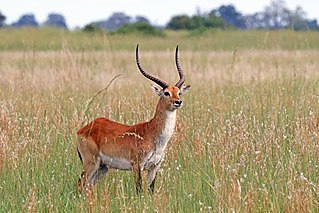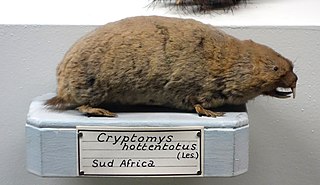
The lechwe, red lechwe, or southern lechwe is an antelope found in wetlands of south-central Africa.

The blesmols, also known as mole-rats, or African mole-rats, are burrowing rodents of the family Bathyergidae. They represent a distinct evolution of a subterranean life among rodents much like the pocket gophers of North America, the tuco-tucos in South America, or the Spalacidae from Eurasia.

The Damaraland mole-rat, Damara mole rat or Damaraland blesmol, is a burrowing rodent found in southern Africa. Along with the smaller, less hairy, naked mole rat, it is a species of eusocial mammal.

Cryptomys is the genus of mole-rats, endemic to Africa. Most of the species formerly placed in this genus were moved to the genus Fukomys in 2006.

Ansell's mole-rat is a species of rodent in the family Bathyergidae. It is endemic to Zambia. Its natural habitats are moist savanna and miombo forests. It is noted for its very long tunnels, up to 2.8 km (1.7 mi) for a single colony of only ten individuals. The colonies are made of an eusocial system. They include a main reproductive king and queen that are thought to be faithful to one another.
Bocage's mole-rat is a species of rodent in the family Bathyergidae. It is found in Angola, Namibia, possibly Democratic Republic of the Congo, and possibly Zambia. Its natural habitats are subtropical or tropical dry forests, dry savanna, subtropical or tropical dry lowland grassland, and caves.

The Mashona mole-rat is a species of rodent in the family Bathyergidae. It is found in Mozambique and Zimbabwe. Its natural habitats are subtropical or tropical dry shrubland, subtropical or tropical dry lowland grassland, and caves.
The Nigerian mole-rat is a species of rodent in the family Bathyergidae. It is found in northern Nigeria and Cameroon. A colonial, subterranean species, its natural habitats are tropical dry lowland grassland, riverside woodland and rocky places.

Mechow's mole-rat is a species of rodent in the family Bathyergidae. It is found in Angola, Democratic Republic of the Congo, Zambia, and possibly Malawi. Its natural habitats are moist savanna, subtropical or tropical dry shrubland, and subtropical or tropical dry lowland grassland. This mole-rat was first described by the German naturalist Wilhelm Peters in 1881. The specific epithet honours the Prussian explorer and naturalist Friedrich Wilhelm Alexander von Mechow.
The Ochre mole-rat is a species of rodent in the family Bathyergidae. It is found in Central African Republic, Democratic Republic of the Congo, South Sudan, and Uganda. Its natural habitats are moist savanna, subtropical or tropical dry shrubland, subtropical or tropical dry lowland grassland, caves, and arable land.
The Ghana mole-rat or Togo mole-rat is a species of rodent in the family Bathyergidae. It is endemic to Ghana.

Sclater's shrew is a species of mammal in the family Soricidae. It is endemic to Mexico.

The San Cristobal shrew is a species of mammal in the family Soricidae. It is endemic to Mexico. It is known only from the Huitepec Ecological Reserve west of San Cristóbal de las Casas in the Chiapas Highlands of central Chiapas. It is found at 2,743 meters elevation in montane and montane cloud forests.
Nothobranchius kafuensis, known as the Caprivi killifish or Kafue killifish, is a species of killifish in the family Nothobranchiidae. This killifish is found in temporary pools, swamps and ditches in the floodplains of the Kafue and Upper Zambezi rivers in western Zambia and the Caprivi Strip in Namibia.
The Zambian mole-rat is a species of rodent in the family Bathyergidae. It is found in Zambia and the Democratic Republic of the Congo. It was formerly considered a subspecies of Cryptomys hottentotus.

The serows are four species of medium-sized goat-like or antelope-like mammals of the genus Capricornis. All four species of serow were until recently also classified under Naemorhedus, which now only contains the gorals.

The Kafue lechwe or Kafue Flats lechwe is a subspecies of the southern lechwe. It is endemic to the Kafue Flats, Zambia. It is listed on the IUCN Red List as vulnerable.

The World's 25 Most Endangered Primates is a list of highly endangered primate species selected and published by the International Union for Conservation of Nature (IUCN) Species Survival Commission (SSC) Primate Specialist Group (PSG), the International Primatological Society (IPS), Global Wildlife Conservation (GWC), and Bristol Zoological Society (BZS). The IUCN/SSC PSG worked with Conservation International (CI) to start the list in 2000, but in 2002, during the 19th Congress of the International Primatological Society, primatologists reviewed and debated the list, resulting in the 2002–2004 revision and the endorsement of the IPS. The publication was a joint project between the three conservation organizations until the 2012–2014 list when BZS was added as a publisher. The 2018–2020 list was the first time Conservation International was not among the publishers, replaced instead by GWC. The list has been revised every two years following the biannual Congress of the IPS. Starting with the 2004–2006 report, the title changed to "Primates in Peril: The World's 25 Most Endangered Primates". That same year, the list began to provide information about each species, including their conservation status and the threats they face in the wild. The species text is written in collaboration with experts from the field, with 60 people contributing to the 2006–2008 report and 85 people contributing to the 2008–2010 report. The 2004–2006 and 2006–2008 reports were published in the IUCN/SSC PSG journal Primate Conservation,, since then they have been published as independent publications.

Fukomys is a genus described in 2006 of common mole-rats, containing several species that were formerly placed in the genus Cryptomys; its species are endemic to Africa.

Zygaspis kafuensis is a worm lizard species in the family Amphisbaenidae. It is endemic to Zambia. Its type locality is located in the Kafue National Park.













